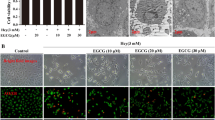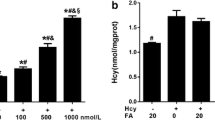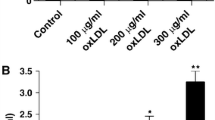Abstract
Objective. Cell death is generally classified into two large categories: apoptosis, which represents active, physiological programmed cell death, and necrosis, which represents passive cell death without underlying regulatory mechanisms. Apoptosis plays an important role in tissue homeostasis and its role in endothelium integrity can be influenced by the functional status of endothelial cells. Homocysteine, a sulfated amino-acid product of methionine demethylation, is an independent risk factor for vascular disease (arterial and venous thombosis). Our goal was to investigate the thiol-derivatives effect on the endothelial cell apoptosis. Methods. Three parameters were measured: mitochondrial membrane potential using DiOC6(3) as the probe, DEVDase activation, and phosphatidylserine exposure on the cell surface with fluorosceinated annexin V labeling which allows apoptosis to be distinguished from necrosis. Results. Homocysteine-thiolactone induced endothelial cell apoptosis in a concentration-dependent manner (range: 50–200 μ M), independently of the caspase pathway. Only homocysteine-thiolactone, among the thiol derivatives tested, induced apoptosis. Apoptosis was not influenced by the serum concentration in culture medium, suggesting that the observed apoptotic process could occur in vivo. None of the inhibitors used (e.g., leupeptin, fumosinin Bl, catalase, or z-VAD-fmk) was able to prevent homocysteine-induced apoptosis of vascular endothelial cells. Conclusion. The apoptosis of vascular endothelial cells induced by high concentration of homocysteine-thiolactone might be one step atherosclerotic cardiovascular disease, and contribute to its complication.
Similar content being viewed by others
References
Kockx MM, Knaapen MW. The role of apoptosis in vascular disease. J Pathol 2000; 190: 267–280.
Alnemri ES, Livingston DJ, Nicholson DW, et al. Human ICE/CED-3 protease nomenclature. Cell 1996; 8: 171.
Petit PX, Lecoeur H, Zorn E, Dauguet C, Mignotte B, Gougeon ML. Alterations in mitochondrial structure and function are early events of dexamethasone-induced thymocyte apoptosis.J Cell Biol 1995; 130: 157–167.
Vayssière JL, Petit PX, Risler Y, Mignotte B. Commitment to apoptosis is associated with changes in mitochondrial biogenesis and activity in cell lines conditionally immortalized with simian virus 40. Proc Natl Acad Sci USA 1994; 91: 11752–11756.
Koopman G, Reutelingsperger CP, Kuijten GA, Keehnen RM, Pals ST, van Oers MH. Annexin V for flow cytometric detection of phosphatidylserine expression on B cells undergoing apoptosis. Blood 1994; 84: 1415–1420.
Homburg CH, De Haas M, Von dem Borne AE, Verhoeven AJ, Reutelingsperger CP, Ross D. Human neutrophils lose their surface Fc gamma RIII and acquire annexin V binding sites during apoptosis in vitro. Blood 1995; 85: 532–540.
Jaffe EA, Nachman RL, Becker CG, Minick CR. Culture of human endothelial cells derived from umbilical veins. J Clin Invest 1973; 52: 2745–2756.
Durrieu F, Belloc F, Lacoste L et al. Caspase activation is an early event in anthracycline-induced apoptosis and allows detection of apoptotic cells before they are ingested by phagocytes. Exp Cell Res 1998, 240: 165–175.
NicholsonDW, Ali A, Thornberry NA et al. Identification and inhibition of the ICE/CED-3 protease necessary for mammalian apoptosis. Nature 1995; 376: 37–43.
Belaud-Rotureau MA, Lacombe F, Durrieu F et al. Ceramideinduced apoptosis occurs independently of caspases and is decreased by leupeptin. Cell Death Differ 1999; 6: 788–795.
Starkebaum G, Harlan JM. Endothelial cell injury due to copper-catalyzed hydrogen peroxide generation from homocysteine. J Clin Invest 1986; 77: 1370–1376.
van Engeland M, Nieland LJ, Ramaeckers FC, Schutte B, Reutelingsperger CP. Annexin V-affinity assay: A review of an apoptosis detection system based on phosphatidylserine exposure. Cytometry 1998; 31: 1–9.
Wall RT, Harlan JM, Harker LA, Striker GE. Homocysteineinduced endothelial cell injury in vitro: A model for the study of vascular injury. Thromb Res 1980; 18: 113–121.
Gordon PB, Levitt MA, Jenkins CS, Hatcher VB. The effect of the extracellular matrix on the detachment of human endothelial cells. J Cell Physiol 1984; 121: 467–475.
Boiadjieva S, Hallberg C, Hogstrom M, Busch C. Methods in laboratory investigation. Exclusion of trypan blue from microcarriers by endothelial cells: An in vitro barrier function test. Lab Invest 1984; 50: 239–246.
BurschW, Oberhammer F, Schulte-Hermann R. Cell death by apoptosis and its protective role against disease. Trends Pharmacol Sci 1992; 13: 245–251.
Green DR. Apoptotic pathways: The roads to ruin. Cell 1998; 94: 695–698.
Kitanaka C, KuchinoY. Caspase-independent programmed cell death with necrotic morphology. Cell Death Differ 1999; 6: 508–515.
Shimizu S, Eguchi Y, Kamiike W et al. Retardation of chemical hypoxia-induced necrotic cell death by Bcl-2 and ICE inhibitors: Possible involvement of common mediators in apoptotic and necrotic signal transduction. Oncogene 1996; 12: 2045–2050.
Tsujimoto Y. Apoptosis and necrosis: Intracellular ATP level as a determinant for cell death modes. Cell Death Differ 1997; 4: 429–434.
Martin SJ, Reutelingsperger CPM, McGahon AJ et al. Early redistribution of plasma membrane phosphatidylserine is a general feature of apoptosis regardless of the initiating stimulus: Inhibition by overexpression of Bcl-2 and Abl. J Exp Med 1995; 182: 1545–1556.
Castedo M, Hirsch T, Susin SA et al. Sequential acquisition of mitochondrial and plasma membrane alterations during early lymphocyte apoptosis. J Immunol 1996; 157: 512–521.
Grafe M, Steinheider G, Desage U et al. Characterization of two distinct mechanisms for induction of apoptosis in human vascular endothelial cells. Clin Chem Lab Med 1999; 37: 505–510.
Galle J, Heermeier K, Wanner C. Atherogenic lipoproteins, oxidative stress, and cell death. Kidney Int Suppl 1999; 71: S62-S65.
Claise C, Edeas M, Chaouchi N et al. Oxidized-LDL induce apoptosis in HUVEC but not in the endothelial EA. hy 926. Atherosclerosis 1999; 147: 95–104.
Kaiser D, Freyberg MA, Schrimpf G, Friedl P. Apoptosis induced by lack of hemodynamic forces is a general endothelial feature even occurring in immortalized cell lines. Endothelium 1999; 6: 325–334.
McCully KS. Vascular pathology of homocysteinemia: Implications for the pathogenesis of arteriosclerosis. Am J Pathol 1969; 56: 111–128.
Tsai JC, Perrella MA, Yoshizumi M et al. Promotion of vascular smooth muscle cell growth by homocysteine: A link to atherosclerosis. Proc Natl Acad Sci USA 1994; 91: 6369–6373.
Tang L, Mamotte CD, Van Bockxmeer M, Taylor RR. The effect of homocysteine on DNA synthesis in cultured human vascular smooth muscle. Atherosclerosis 1998; 136: 169–173.
Hajjar KA. Homocysteine-induced modulation of tissue plasminogen activator binding to its endothelial cell membrane receptor. J Clin Invest 1993; 91: 2873–2879.
Ross R. The pathogenesis of atherosclerosis-A perspective for the 1990's. Nature 1993; 362: 901–909.
Mercié P, Seigneur M, Conri C, Boisseau MR. Hyperhomocysteinaemia and endothelial dysfunction in peripheral arterial disease. Thromb Res 1999; 93: 97–99.
Mercié P, Baste JC, Sassoust G, Ged C, Parrot F, Conri C. Factor V Leiden, mild hyperhomocyst(e)inemia and Buerger's disease. Microvasc Res 1998; 55: 271–272.
Velury S, Howell SB. Measurement of plasma thiols after derivatization with monobromobimane. J Chromatogr 1988; 424: 141–146.
Stamler JS, Osborne JA, Jaraki O et al. Adverse vascular effects of homocysteine are modulated by endothelium-derived relaxing factor and related oxides of nitrogen. J Clin Invest 1993; 91: 308–318.
Anderson A, Lindgren A, Hultberg B. Effect of thiol oxidation and thiol export from erythrocytes on determination of redox status of homocysteine and other thiols in plasma from healthy subjects and patients with cerebral infarction. Clin Chem 1995; 41: 361–366.
Welch GN, Upchurch GR, Jr, Loscalzo J. Hyperhomocyst( e)inemia and atherothrombosis.Ann N Y Acad Sci 1997; 811: 48–58.
Eikelboom JW, Lonn E, Genest J, Jr, Hankey G, Yusuf S. Homocyst(e)ine and cardiovascular disease: A critical review of the epidemiologic evidence. Ann Intern Med 1999; 131: 363–375.
Jakubowski H. Metabolism of homocysteine thiolactone in human cell cultures: Possible mechanism for pathological consequences of elevated homocysteine levels. J Biol Chem 1997; 272: 1935–1942.
Jakubowski H, Zhang L, Bardeguez A, Aviv A. Homocysteine thiolactone and protein homocysteinylation in human endothelial cells. Circ Res 2000; 87: 45–51.
Jabukowski H. Protein homocysteinylation: Possible mechanism underlying pathological consequences of elevated homocysteine levels. FASEB J 1999; 13: 2277–2283.
Koch HG, Goebeler M, Marquard T, Roth J, Harms E. The redox status of aminothiols as a clue to homocysteine-induced vascular damage? Eur J Pediatr 1998; 157(Suppl 2): S102-S106.
Author information
Authors and Affiliations
Rights and permissions
About this article
Cite this article
Mercié, P., Garnier, O., Lascoste, L. et al. Homocysteine-thiolactone induces caspase-independent vascular endothelial cell death with apoptotic features. Apoptosis 5, 403–411 (2000). https://doi.org/10.1023/A:1009652011466
Issue Date:
DOI: https://doi.org/10.1023/A:1009652011466




